Diervilla and Lonicera spp.
With its honey-sweet fragrance, colorful blossoms, and graceful vining growth habit, it’s easy to fall in love with honeysuckle.
So many people have a cherished memory of sipping the sweet nectar from the flowers, or reveling in the perfumed summer air.

We link to vendors to help you find relevant products. If you buy from one of our links, we may earn a commission.
But these days, you’re just as likely to hear about the not-so-sweet side of honeysuckles as you are about the memories that the scent of the flowers bring.
Certain species of honeysuckle, while lovely in their native habitat, have become invasive nuisances that are wreaking absolute havoc in some areas.
In this guide, we’ll help you pick varieties that won’t cause trouble down the road. We’ll also help you plant and care for your honeysuckles so you can enjoy all that they have to offer.
Up ahead, we’ll cover the following:
What You’ll Learn
If you can’t wait to get your hands on some honeysuckle, then read on!
Cultivation and History
Honeysuckles are flowering shrubs and vines in the Caprifoliaceae family.
There are dozens of species, but only a handful that are grown in home gardens, and most of those come from the Lonicera genus, with some belonging to the Diervilla genus as well.
The plants are native to temperate zones across the northern hemisphere. You can find them throughout Eurasia and North America.
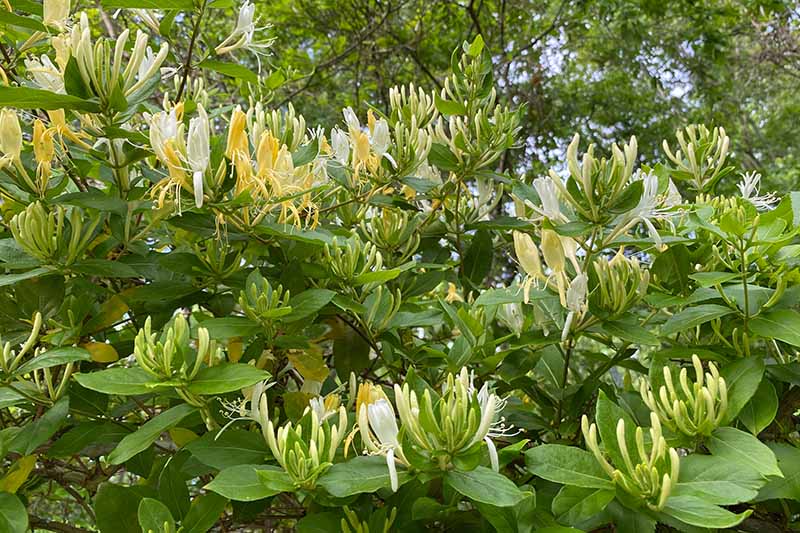
When it comes to vining types, trumpet or coral (Lonicera sempervirens), Japanese (L. japonica), sweet or Italian (L. caprifolium), Burmese (L. hildebrandiana), woodbine or European (L. periclymenum), Morrow’s (aka Amur) (L. morrowii), goldflame (L. heckrottii), and evergreen (L. henryi) are the most commonly found species at nurseries and in gardens.
Shrub types include winter (L. fragrantissima), northern bush (Diervilla lonicera), mountain bush (D. rivularis), and southern bush (D. sessilifolia).
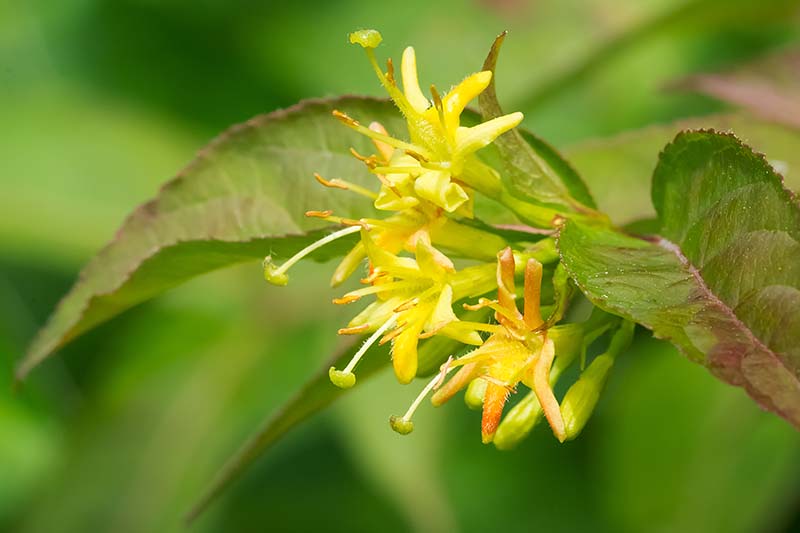
Some, such as Himalayan honeysuckle (Leycesteria formosa), can be grown as a vine or a shrub. However, this particular variety is not grouped traditionally with other honeysuckles, thanks to its differences in habit and growing requirements. It is, however, a close relative to the species mentioned here.
You can learn more about Himalayan honeysuckle in our guide.
Bush honeysuckles spread via suckers and seeds, and can tolerate a good amount of drought and compacted soil. Vining types spread via seeds, and climb by wrapping themselves around other plants or support structures.
Interestingly, honeysuckle always climbs in a clockwise spiral.
These plants are rarely impacted by pests or diseases, and can grow in a wide range of light exposure and soil moisture levels.
There are plants that can handle full shade and others that thrive in full sun. Most are adaptable to anything from dry to moist soil, and clay to sand.
Their adaptability has contributed not only to their popularity in gardens, but to their invasive spread in many parts of the country as well.
Many are native to different parts of the US, while some species were imported to the US – usually from Asia via Europe – and are now considered invasive or noxious, such as Amur (L. maackii), Japanese (L. japonica), bella or Bell’s (L. x bella), and Tartarian (L. tatarica).
Some states even ban the import or planting of some of these, so be sure to check local regulations before you choose what to grow.
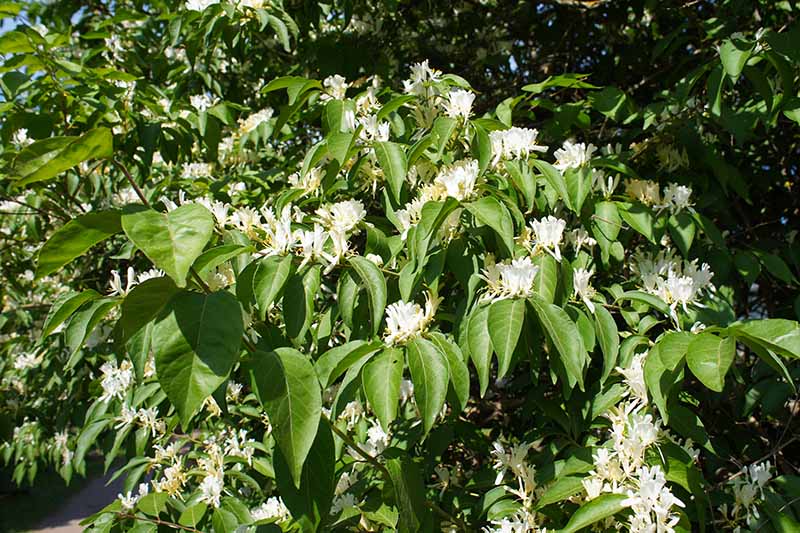
Collectively, these potentially invasive plants are sometimes referred to by the outdated terms “exotic” or “Asian” honeysuckle, but not all honeysuckles from Asia are invasive.
Many honeysuckles were brought to the US not only for their beautiful flowers, but because they have the ability to survive in a range of conditions and climates, and could help with erosion. What many people didn’t realize is that they could become invasive.
For instance, growers in Japan and Europe didn’t know how aggressive the Amur honeysuckle would become in the US, since it didn’t have the same problem in those areas. In fact, the Amur type is considered endangered in Japan.
But once Amur’s took hold in US soil, it rampantly started taking over, smothering native flora.
Even if these types aren’t banned outright in your area, you should really consider whether it’s worth planting them or not. They can have a seriously negative impact on local flora, and they can easily outcompete native plants for light, water, and nutrients.
They can also leaf out earlier than native plants, smothering seedlings or blocking seeds from accessing light and water before they can get a good start.
Fortunately, there are many excellent options available that don’t become invasive.
Most of the native plants come from the eastern half of the US, but there are a few that are native to the west.
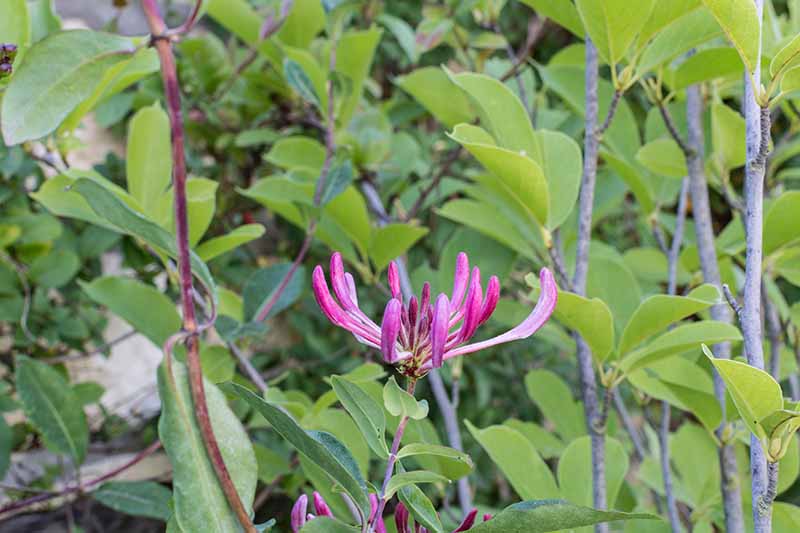
The climbing or orange honeysuckle (L. ciliosa) grows on the west coast and has incredibly showy trumpet-shaped orange flowers, and purple honeysuckle (L. hispidula) grows near the Pacific Ocean and features purple-pink flowers.
Coral honeysuckle is beautiful, adaptable, and native to the eastern US, so it doesn’t become invasive there. It is one of the most commonly available varieties to purchase from nurseries out there.

The native plants have been an important resource for indigenous people in North America.
Native Americans have historically used and continue to use honeysuckle for medicinal purposes, including treating sore throats, coughs, colds, and epilepsy, and to ease upset stomachs, among other uses.
For instance, the Navajo people use Arizona (L. arizonica) and twinberry honeysuckle (L. involucrata) as emetics in ceremonies. The Iroquois use American fly honeysuckle (L. canadensis) as a blood purifier, a sedative, and to cure homesickness.
Orange or climbing honeysuckle (L. ciliosa) is used by the Swinomish people for treating colds, while the Klallam use it as a topical bruise healer.
Regardless of where they originate, all honeysuckles share some similarities.
The leaves are often clasping, which means the leaf wraps around the stem rather than attaching to it with a petiole. They can also be perfoliate, which means the stem appears to pierce the leaf, or petiolate, which means they have a small stalk that attaches to the stem.
The leaves grow in pairs with each leaf opposite the other, and are ovate or oblong-ovate in shape.
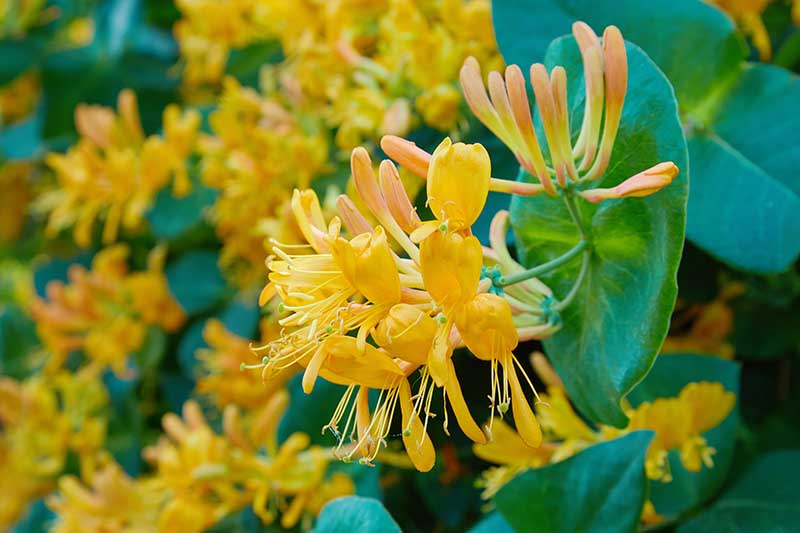
Flower colors can be white, cream, yellow, orange, red, lavender, purple, or maroon. The flowers are tubular and usually appear in pairs or clusters. Many types have multicolored blossoms.
The flowers, which are usually strongly fragrant with a pungent honey-like scent, are followed by berries in the fall. These are typically red, orange, or yellow.
Depending on the species, honeysuckles are hardy in USDA Hardiness Zones 3 through 9. They come in evergreen, semi-evergreen, and deciduous varieties.

Don’t confuse Cape honeysuckle (Tecoma capensis) with the rest of the plants in this group. Though it also shares this common name, it’s not a close relative.
Honeysuckle Plant Propagation
Honeysuckle is easy to propagate, but if you find a plant growing in the wild, be sure you identify it before you take a cutting or try layering. You don’t want to spread an invasive species further.
As a first step to figuring out what variety it is, try snapping off a piece of hardwood. The most common invasive types have a hollow channel down the center of the stems, while species native to the US have a solid stem.
From Seed
Hybrids won’t grow true from seed, but many species and cultivars can. You can purchase seeds at most nurseries.
The seeds require cold stratification before they will germinate. There are two ways to make this happen.
The first is to put the seeds in the soil in the fall and let Mother Nature do her thing. Keep in mind, however, that if the seeds break early during a warm snap in February, they might be killed when colder temperatures return.
The other method is to trick the seeds into thinking they’ve been through a cold winter. This takes some extra work, but it’s more reliable. Two months before you intend to plant, start the process.
Fill a resealable bag or jar with sand and thoroughly wet it. The sand should be wet enough that if you squeeze it in your hands it stays together rather than crumbling apart, but you don’t want it to be muddy. Add the seeds and mix them into the sand.
Seal the container or bag and put it in the fridge, preferably in a back corner where it won’t be impacted by the changing temperatures that foods at the front of the fridge experience.
Check weekly to make sure the sand is staying moist. Add a little water if it’s drying out.
After two months, you can plant the seeds.
To plant seeds either in the fall or spring after you stratify them, first prepare the soil.
Honeysuckle can tolerate a range of soils, but you should work in some compost to make your soil as loamy and well-draining as possible.
Place the seeds in the soil 1/8 inch deep. Moisten the soil with a water bottle or a hose attachment set to mist. Maintain even moisture as the seeds germinate, which should take a few weeks.
Unlike veggies, which you might want to start indoors in order to get a jump on the growing season, you don’t need to start honeysuckle inside. Once it’s in the ground, it starts to take off, and will begin to flower by the time its other outdoor pals do.
All that said, if you want to start your seedlings indoors, you are certainly welcome to do so. If you go this route, about six weeks before the average last predicted frost date, start them 1/8 inch deep in three-inch peat pots or CowPots filled with a seed starting mix.
Never heard of CowPots? They’re awesome. They’re made out of cow poop, so they’re sustainable and they biodegrade right into the soil, so your plant gets less of a shock from the transition.
Arbico Organics carries them in packs of 12, 400, and 840 so you never have to be without.
Water the seeds well and keep the soil moist until the seedlings that sprout have one set of true leaves.
Harden the seedlings off by bringing them outside for an hour and putting them in a sheltered spot. Then, bring them back in. On day two, add an hour.
Keep adding an hour until a week goes by. Now the plants are ready to go into their permanent home.
From Cuttings
Cuttings can be taken from softwood growth in the spring before flowering.
Cut off a branch with at least two leaf pairs. Snip the branch just above the uppermost leaf pair and pull off the lower leaf pair. Place the cutting in a rooting medium with the leaves positioned upright, and water well.
To help the cutting stay warm and moist, place a plastic baggy over it. Use a chopstick to prop up the bag and to provide the cutting with a support structure to climb up if it’s a vining type.
Remove the bag every few days to check on things. Make sure the soil is staying moist and the air is humid. Mist the cutting if it feels dry inside the bag and add water if the soil feels dry at all.
After a few weeks, the cutting should have formed some roots. Give the cutting a little tug and see if it resists. If so, it’s ready to be transplanted.
However, before you go stick it in its permanent home, be sure to harden it off as described above.
Layering
Honeysuckles are a cinch to layer. It’s as simple as choosing a branch and placing it flat on the soil without detaching it from the parent plant.
Remove any leaves from the middle of the branch. Then, cover the middle with about an inch of soil, leaving a few inches of the tip exposed. You can use a rock to pin the branch down if it doesn’t want to stay in place.
Add water if the soil dries out. Otherwise, you don’t need to do anything but practice some patience.
After a month, you should see a stem and new leaves forming. When this happens, snip the branch free of the main plant and dig up the buried section. It should have roots and will be ready to be transplanted.
From Seedlings/Transplanting
Before you plant your seedlings, dig your hole. It should be slightly wider and deeper than the existing container.
Work some compost into the removed soil and put some back in the base of the hole so that the plant will sit at the same level as it is at in its container.
Be sure to put your trellis or other support in place if you’re growing a vining type.
Gently remove the plant from its container by gripping it around the base and wiggling it out. Check for any dead or dry roots and cut them off. Loosen the soil and gently straighten out any circling or tangled roots.
Place the plant in the hole, and fill in around it with your soil and compost mix. Water well to help settle the soil.
Once it’s in its new home, trim back the branches by about a third to encourage bushier growth, unless it’s a young seedling with just a few leaves – no need to trim that.
As the plant grows, help to wind it around the support structure, or you can affix a few of the tendrils by tying them loosely to the support with twine or rope.
How to Grow Honeysuckle Flowers
Vining or climbing honeysuckles can grow in part sun to full sun, with the best flowering in full sun.
In a perfect world, the top of vines will be in full sun with their roots in the shade. Bush types can usually handle a bit more shade.

Before you plant, make sure you pick a spot that has enough space. Some honeysuckles grow to be extremely large and they can quickly outgrow their location if you don’t choose wisely.
Climbing types need something to support them, whether that’s a trellis, a fence, or an arbor. They don’t have tendrils or adhesive roots like some vines such as ivy do.
They attach themselves to structures by winding around them. They won’t attach themselves to walls; they need something that they can wrap around.
As a result, any support structure should be placed about an inch or more away from a wall so the vine can do its thing.
Some bush types can stay fairly compact. Vining types can reach as far as 30 feet or more. Know your plant and plan accordingly.
Also be aware that when the flowers are blooming, the plants can be absolutely covered in bees. While that’s a good thing, you might not want to have a million bees hovering right near you if you or someone you live with is allergic.
You should also keep in mind that hummingbirds love most honeysuckles. If you don’t want to disturb them while they’re feeding, don’t plant too close to walkways or patios.
When it comes to soil, these plants are astonishingly adaptable. Most can handle anything from moist to dry soil once they are established. They can also tolerate clay or sandy soil, though loamy, rich, well-draining soil is preferred.
Boggy soil will kill them off, however. They can’t handle standing water around their roots.
That said, I had a garden with clay soil, and I struggled to get plants to thrive, particularly in the low areas where water pooled. But my honeysuckle always grew fabulously well after it became established, even in the boggy areas. You never know how well these plants can adapt until you try.
While they prefer slightly acidic soil, a pH between 5.5 and 8.0 is sufficient.
After you’ve gotten them in the ground, vining types will need some training. For the first year, go out every few weeks and train the tendrils around their support structure in the direction you want them to grow.
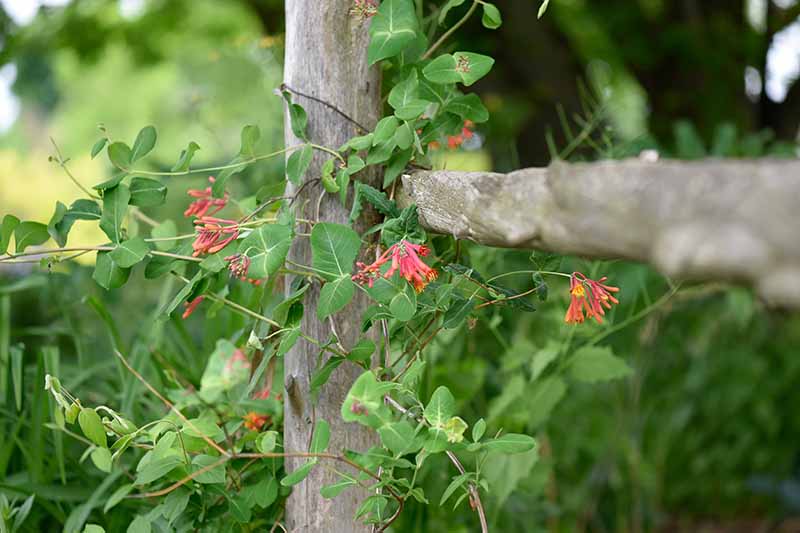
When it comes to watering, most don’t need additional moisture once they’re established beyond what nature provides, but keep an eye on your plants. In the height of summer, provide additional water when the top few inches of soil dry out.
If they start to wilt or turn brown on the edges of the leaves, you’ll need to add supplemental water, at least during the warmer times of year.
Also note that since vining types are often grown near walls, they might not be receiving as much water as they should, since walls can block rain or irrigation.
Fertilize with a formula made for flowering plants once a year in the spring. You can apply fertilizer every other year instead, as long as your plant is blooming well.
Anything too high in nitrogen will result in leaf growth at the expense of flowering.
I use a side-dressing of Down to Earth’s Rose and Flower mix because it’s perfectly formulated to encourage flowering, and made with organic ingredients. The container is even compostable.
Down to Earth Rose and Flower Mix
Arbico Organics carries one- and five-pound containers of this tried-and-true fertilizer as well as bulk options.
Growing Tips
- Plant in full or part sun.
- Provide vining types with something to climb up.
- Provide water when the top few inches of soil dry out.
Pruning and Maintenance
Most vining honeysuckles don’t need a lot of pruning unless you need to contain an aggressive grower.
Otherwise, prune yearly to provide some shape in the fall after flowering. You can remove up to a third of the stems and foliage at a time.
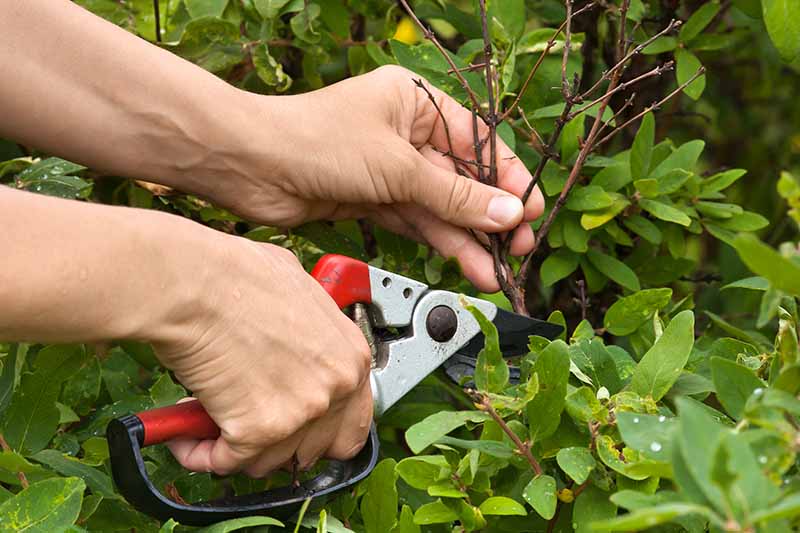
If your plant is becoming leggy or rangy, prune it hard in the fall. Plants that become bare at the base or in the center should also be pruned back to the ground. Don’t worry, you can cut them back to the trunk and they will return in the spring, usually with bushier growth.
Shrub honeysuckles can be lightly pruned to maintain their shape in the early spring, before new growth appears. Prune out any dead branches.
Don’t prune in midspring to summer. Not only can this stress the plant or reduce blooming, since many honeysuckles bloom on the current season’s growth, but many types of birds like to make nests in the branches and you might disturb them.
Some honeysuckles bloom on last season’s growth, however, so check on your particular species to see what you have. Those types should be pruned in the fall.
Each year, you might want to go out just before flowering and train the vines in the direction that you want them to grow.
Removal
If you planted or have an invasive type in your yard already that you want to get rid of, be prepared. You have a challenge ahead of you, but it is possible.
These plants have become such a problem in some areas that there is actually a tool made just for digging them out called a honeysuckle popper.
It’s a tool that lets you wedge a piece of it below the root structure, helping you to create leverage to pop it out of the ground, root and all.
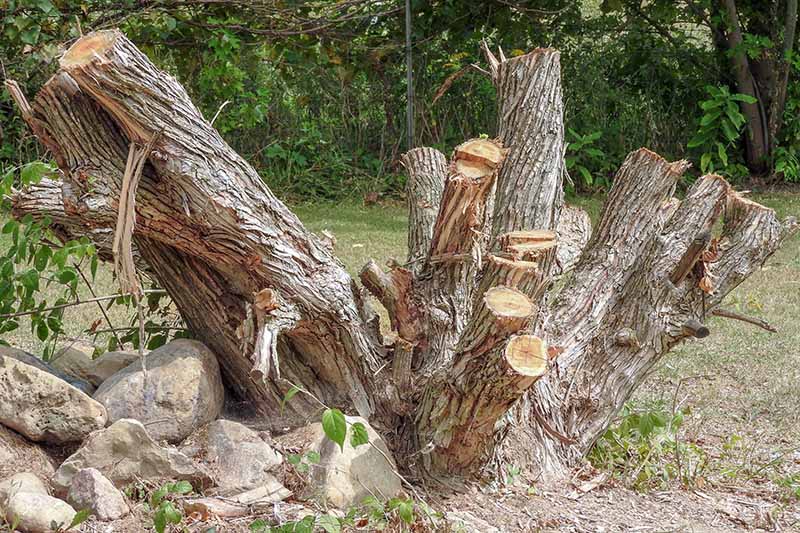
You can also use a garden fork and shovel to try and dig the whole thing out. Plan to dig out as much of the root structure as you can.
If you simply can’t dig up the entire root structure because the plant is too large, your best bet is to saw the stem off at the ground, then treat the exposed stem with a 20 percent solution of glyphosate.
Keep an eye out over the next few weeks (and months – sorry!) and rip out any shoots that pop out of the soil.
Honeysuckle Species and Cultivars to Select
Before you pick a variety to grow at home, you’ll need to narrow things down a little.
First, do you want a shrub or a vining plant? Second, do you want something that is fragrant? Not all honeysuckles are. Next, make sure the plant that you pick grows well in your region and is the right size for your needs.
Finally, you should also be sure to check with your local ag agency to see if the plant is listed as invasive.
As much as we love the hardiness and beauty of Japanese honeysuckles, we don’t want them to strangle native flora. There might be better options out there that won’t threaten native plants.
Many plants found in nurseries today are hybrids of species that are native to the US, and there are new cultivars and hybrids popping up all the time.
D. Lonicera
This species is usually just called “bush,” which denotes its growth habit.
‘Dwarf Bush’ is a – yup, you guessed it – dwarf cultivar of D. lonicera. It may stay under four feet tall and wide, though a max height closer to eight feet is common.
D. Rivularis
Rivularis varieties are also called mountain bush or hairy bush honeysuckles.
‘Kodiak Black’ (D. rivularis ‘SMNDRSF’) is a shrub type that grows about five feet wide and four feet tall in Zones 5 to 7.
It’s highly fragrant, can handle just about any type of soil, and thrives in sun, part shade, or even full shade.
This honeysuckle cultivar is exceptional not just for the flowers, but its dark purple, nearly black foliage as well.
In the early summer, bright yellow, trumpet-shaped flowers emerge and last through the fall. If you’re looking for a bush honeysuckle, it’s hard to go wrong with this one.
D. Sessilifolia
The sessilifolia species is a group collectively known as the southern bush honeysuckles.
‘Cool Splash’ (D. sessilifolia ‘LPDC Podaras’ PP19391) is a dwarf southern bush that stays under four feet tall and wide, with a mounding growth habit.
It isn’t invasive but it is still hardy, grows extremely fast, and can handle a range of conditions.
By the way, that “PP” followed by a bunch of numbers is what’s known as a plant patent ID.
These patents are granted to an individual or group who invent a new plant through asexual breeding. That means they own the rights to the plant for 20 years. But I digress…
When it isn’t covered in fragrant yellow flowers, the variegated green and cream foliage adds color to the garden. It grows in Zones 4 to 7 in partial shade to full sun.
Nature Hills Nursery carries this stand-out bush in #3 containers.
L. Flava
Yellow honeysuckle (L. flava) has extremely fragrant sweet-smelling flowers that are, unsurprisingly, yellow, though they can have a hint of orange.

L. flava ‘Yellow’ is a vining plant that reaches up to 20 feet tall and six feet wide, and is hardy in Zones 5 to 8.
L. Periclymenum
The periclymenum species was imported from Europe, and thank goodness it isn’t invasive. It’s also known as common honeysuckle or woodbine.
L. periclymenum ‘Fragrant Cloud’ is, as its name would suggest, highly fragrant.
Also referred to by the name ‘Chojnow’ PBR, denoting a cultivar registered with Plant Breeders’ Rights to be sold under a code name or with alternate names of a different language, this variety has white and magenta flowers.
‘Fragrant Cloud’ is hardy in Zones 5 to 9, and reaches up to 10 feet tall and eight feet wide. It’s a vining type that can handle partial sun or full sun.
L. Sempervirens
Coral, trumpet, or scarlet honeysuckle (L. sempervirens) is an excellent choice if you want a non-invasive option to replace Japanese honeysuckle.
It’s vigorous, pest and disease resistant, flowers profusely, and is extremely low maintenance.
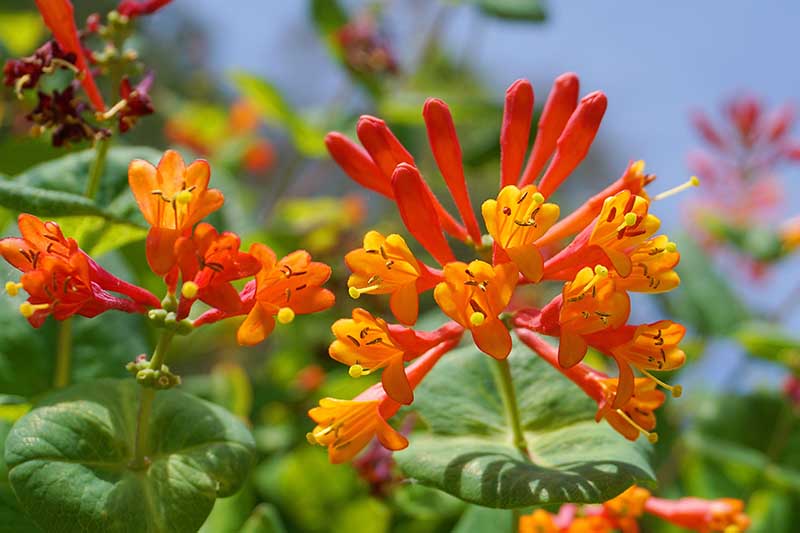
The large flowers are red or burgundy on the outside, and gold, yellow, or orange in the center, though there are a few cultivars with different blossom colors.
It can grow in a wide range of Zones from 4 to 9, and even in Zone 3 with some winter protection. It grows to 20 feet tall with support, and six feet wide.
This species grows incredibly quickly without being invasive, which is probably why it’s one of the most popular North American honeysuckles out there.
There are a few exceptional coral cultivars worth watching for:
‘Cedar Lane’ has two-inch-long flowers that are vermillion on the exterior and yellow on the interior. ‘Alabama Crimson’ features crimson red flowers with dark green-blue leaves. ‘John Clayton’ has bright yellow flowers, and it tends to rebloom a second time each year.
‘Major Wheeler’ is such a prolific bloomer that you can’t tell it even has foliage when it’s blooming. The bright red and orange tubular flowers emerge in late spring and stick around until autumn.
It grows quickly and is partially evergreen in Zones 6 to 8, though it can grow in gardens down to Zone 4. And it spreads about 10 feet wide and eight feet tall.
Hybrids
L. x brownii ‘Dropmore Scarlet’ is a vining type that is vigorous without being invasive. It has intensely scented two-inch-long blossoms in pink and orange.
This is a hybrid cross between L. sempervirens with L. hirsuta. It doesn’t get too large, staying right around five feet tall and wide, and is hardy in Zones 4 to 8.
Is she calling your name? Pick this fragrant lady up at Nature Hills Nursery in #3 containers.
Gorgeous ‘Goldflame’ (Lonicera × heckrottii) is a vining type with stand-out flowers that feature bright orange-yellow interiors and medium purple-pink exteriors.
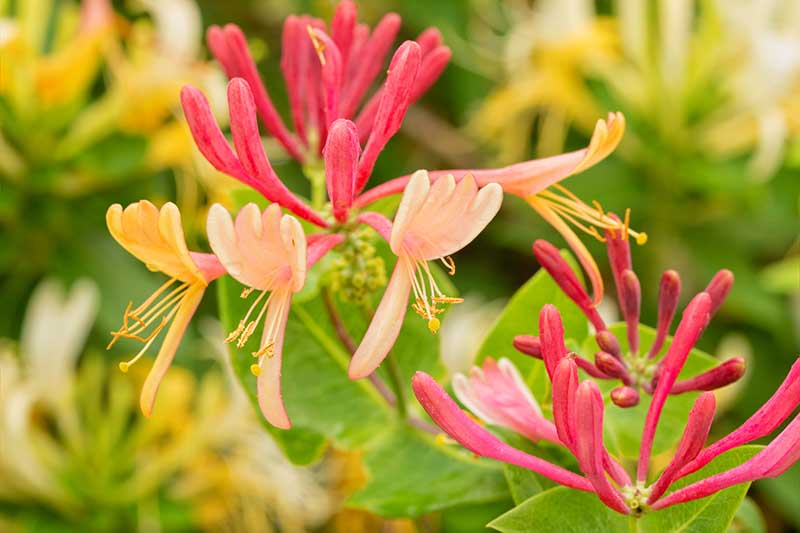
It was created by crossing L. americana and L. sempervirens, and is hardy in Zones 4 to 9. In the right conditions, it quickly grows to 15 feet.
Want More Options?
Be sure to check out our follow-up guide, “Types of Honeysuckle Plants: 13 of the Best Species for Your Garden,” to find the best selections for your yard and garden.
Managing Pests and Disease
One of my favorite things about growing honeysuckle is that it is wonderfully untroubled by pests and diseases.
I’ve never had to deal with either in my garden, though I know a few people who have seen aphids and powdery mildew on their plants.
Herbivores, on the other hand… Let’s just say the deer seem to think honeysuckle is the equivalent of their own personal candy shop.
Herbivores
More than pests and diseases, herbivores have the potential to cause problems because they can’t resist the tender young leaves and flowers of honeysuckle.
Deer
It’s no wonder deer like honeysuckle. If you’ve ever popped the flowers out and sucked the sweet juice from the base, you know that they’re tasty.
If you have deer in your area, you’ll need to deter them or you risk losing your plants. We have a helpful guide with lots of different options to deter deer.
Rabbits
Wild bunnies love young honeysuckle leaves and flowers. They won’t bother the woodier parts of the plant, so your vine or bush is usually safe once it grows a bit older.
To protect your young plants, barriers are your best option. Our article on deterring rabbits can help.
Insects
One of the reasons honeysuckles are so popular is because they’re generally untroubled by insect pests. There’s only one type that you will commonly come across.
Aphids
Perhaps it would be easier to list the plants aphids don’t like to attack than the ones they do.
Honeysuckle is yet another plant that aphids – Hyadaphis foeniculi in particular, in this case – just can’t stay away from. And they’re the most problematic pest you’ll encounter when growing honeysuckle.
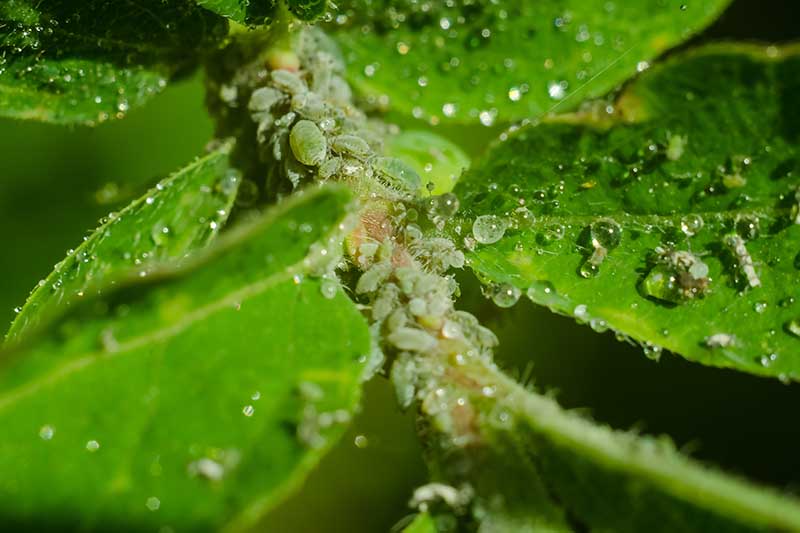
The good news is that controlling and getting rid of them isn’t too difficult. Unless you have young plants and a seriously large infestation, aphids don’t cause too much damage.
Chances are you’ll come across the fly honeysuckle aphid or coriander aphid, as it is commonly known, as well as other types of aphids, in your garden at some point.
Give our guide to controlling these common pests a read to learn how to prevent, spot, and stop them.
Disease
Just as you don’t often see pests on honeysuckle, you’ll rarely encounter diseases either.
Powdery mildew is more common, but you’ll sometimes see leaf blight, as well. Neither will typically kill your plant unless it is young or weak.
Leaf Blight
Leaf blight is caused by the fungus Insolibasidium deformans. If this fungus is present, new leaves in the spring will show light yellow or tan patches at first. Those spots eventually darken and become necrotic over the growing season.
The underside of affected leaves will have a silver, powdery coating, which is the fungus. The leaves will eventually curl and fall from the plant.
Prevention is best, and you can do that by keeping the plants pruned and well-spaced, and watering at the soil level rather than on the foliage. Clean up fallen leaves in the fall, since the fungi overwinters on plant material.
If it’s too late for prevention, you’ll need to break out the antifungals. Copper sprays are effective against this disease.
I like Bonide’s Liquid Copper, which is available at Arbico Organics in 16- or 32-ounce ready-to-use containers, or a 16-ounce concentrate.
Spray plants every 10 days or so for as long as symptoms are present. Be sure to spray the undersides of the leaves.
Powdery Mildew
Powdery mildew is another fungal disease. It’s caused by the pathogen Erysiphe caprifoliacearum var. flexuosa. Again, it’s not extremely common, but it infects plants more frequently in areas with high humidity.
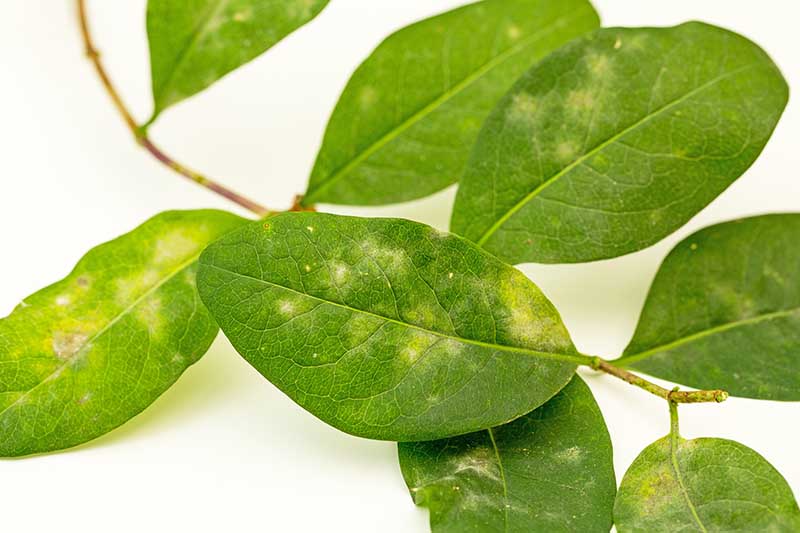
Symptoms include a powder-like coating on leaf surfaces, branches, and buds. Leaves may become yellow, and these will turn dry and fall off the plant.
Planting in a spot where the morning dew can dry off the leaves quickly, and keeping plants well-spaced and pruned, goes a long way to preventing this disease. Also be sure to remove any dead plant material from the ground in the fall.
If your plants do end up with powdery mildew, try an antifungal such as a copper fungicide as described above, or a sulfur fungicide.
Treat every 14 days until symptoms are resolved.
Arbico Organics carries one- and four-pound bottles of Bonide Sulfur treatment.
Early treatment is best. Once this fungus has gotten its hooks into your honeysuckle, it’s hard to eliminate.
If treatment isn’t helping, stop treating and let the plant go dormant in the fall. Then, in the spring as the leaves emerge, start spraying again even if you can’t see any symptoms. It’s a lot easier to prevent the disease from taking hold than it is to get rid of it.
Learn more about how to treat powdery mildew in our guide.
Best Uses for Honeysuckle Vines
Both bush and vine types are lovely in cottage gardens, and they add an intense fragrance to the air throughout the summer.
Bushes do well as hedges or they can be used to provide height in a garden. Vining types are perfect to cover fences, trail down rock walls, or cover trellises and arbors.
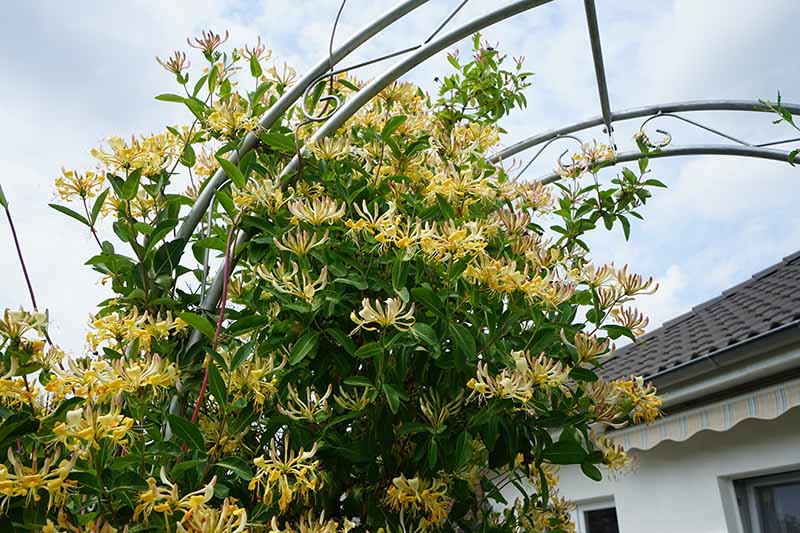
Plant anywhere you want to enjoy the fragrance, such as next to windows or patios. Just remember that the blossoms also attract bees.
To create a hummingbird garden, plant with firecracker plant, columbine, hummingbird plant, woodland pinkroot, bee balm, foxgloves, butterfly bush, or salvia.
Of course, lots of kids (and adults like myself) like to pinch the flowers and pull out the stamen, which has a few drops of sweet nectar on it.
Just be sure that if you eat from a plant that you don’t know, check to see if it has been sprayed with chemicals first. You should also always be certain that you have properly identified your plant if you’re foraging.
You can eat the flowers of some species as well. They’re lovely in salads or as a topper for desserts. Try sugaring them, with these instructions from our sister site, Foodal.
Honeysuckle flower tea is exceptional. It’s naturally sweet and floral tasting. But again, use caution.
While there are a few species that are not at all poisonous, most have some level of toxicity and can cause serious health issues in large enough doses.
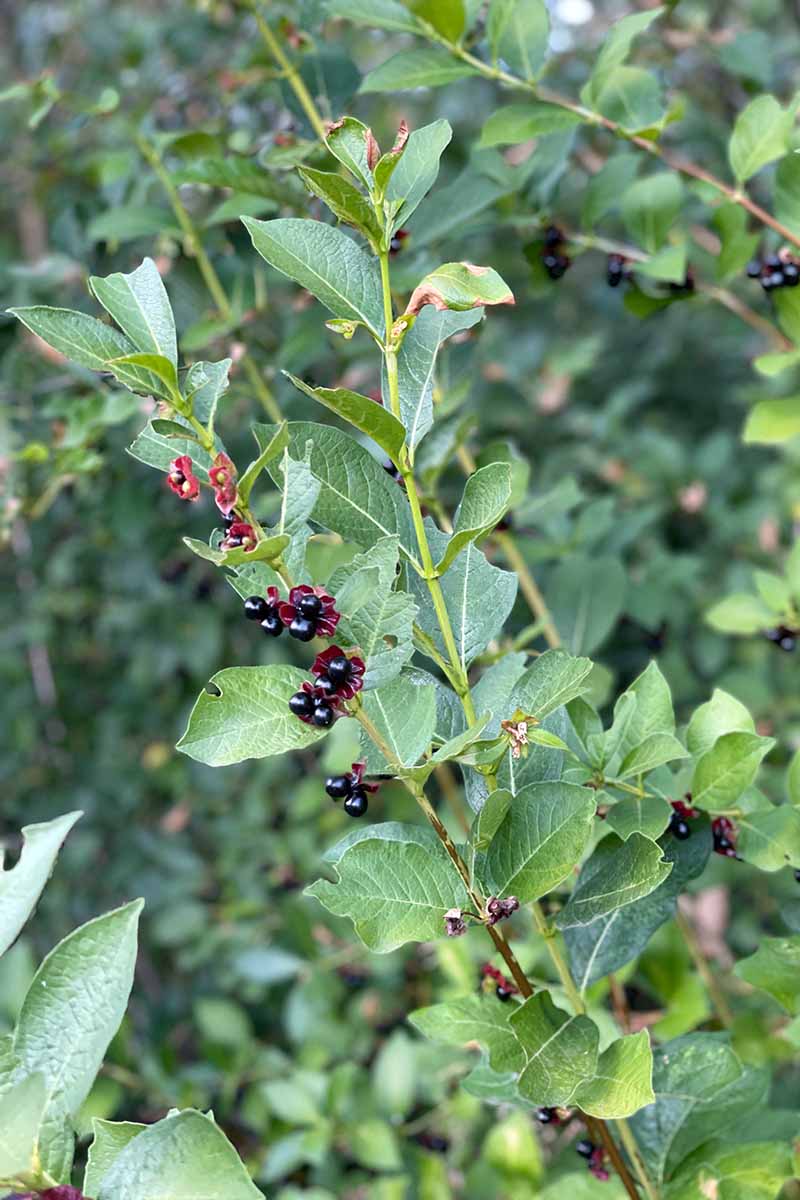
Also, be aware that most honeysuckle species have berries that are poisonous, and these can be toxic particularly if you eat them in large enough quantities.
A few have edible berries (such as L. involucrata and L. utahensis, which are known as twinberry honeysuckles), but it’s probably smart to check with an expert before you start harvesting the berries.
If you can’t be sure, leave them to the birds; they’ll appreciate the snack. Leaves and stems may also be poisonous, though not always. Better safe than sorry.

The berries from some species may also be used to make a natural dye, giving hair and textiles an inky purple hue.
All parts of the plant are highly toxic to canines and felines.
Quick Reference Growing Guide
| Plant Type: | Woody flowering shrub or vine | Flower / Foliage Color: | Cream, white, yellow, pink, orange, red, purple, magenta/green, cream |
| Native to: | Eurasia, North America | Tolerance: | Drought, some shade |
| Hardiness (USDA Zone): | 3-9 | Maintenance | Low |
| Bloom Time: | Spring-summer | Soil Type: | Clay, loamy, sandy |
| Exposure: | Full sun to part shade | Soil pH: | 5.5-8.0 |
| Time to Maturity: | 5-10 years | Soil Drainage: | Well-draining |
| Spacing: | 5-10 feet, depending on species | Attracts: | Bees, butterflies, hummingbirds |
| Planting Depth: | 1/8 inch (seeds), depth of container (transplants) | Companion Planting: | Bee balm, butterfly bush, columbine, firecracker plant, foxgloves, salvia, woodland pinkroot |
| Height: | 4-30 feet | Avoid Planting With: | Clematis |
| Spread: | 4-10 feet | Uses: | Mass planting, hedge, wall or rock garden, dye, edible nectar |
| Growth Rate: | Moderate to fast | Family: | Caprifoliaceae |
| Water Needs: | Low to moderate | Genus: | Lonicera, Diervilla, Leycesteria |
| Common Pests and Disease: | Deer, rabbits; aphids; leaf blight, powdery mildew | Species: | Americana, arizonica, bella, caprifolium, ciliosa, fragrantissima, flava, heckrottii, henryi, hispidula, involucrata, japonica,, hildebrandiana, lonicera, morrowii, periclymenum, rivularis, sempervirens, sessilifolia, tatarica |
Bring the Sweetness of Honeysuckle to Your Home
The experience of the pungent, sweet scent of honeysuckle on the air is something you’re not likely to ever forget.
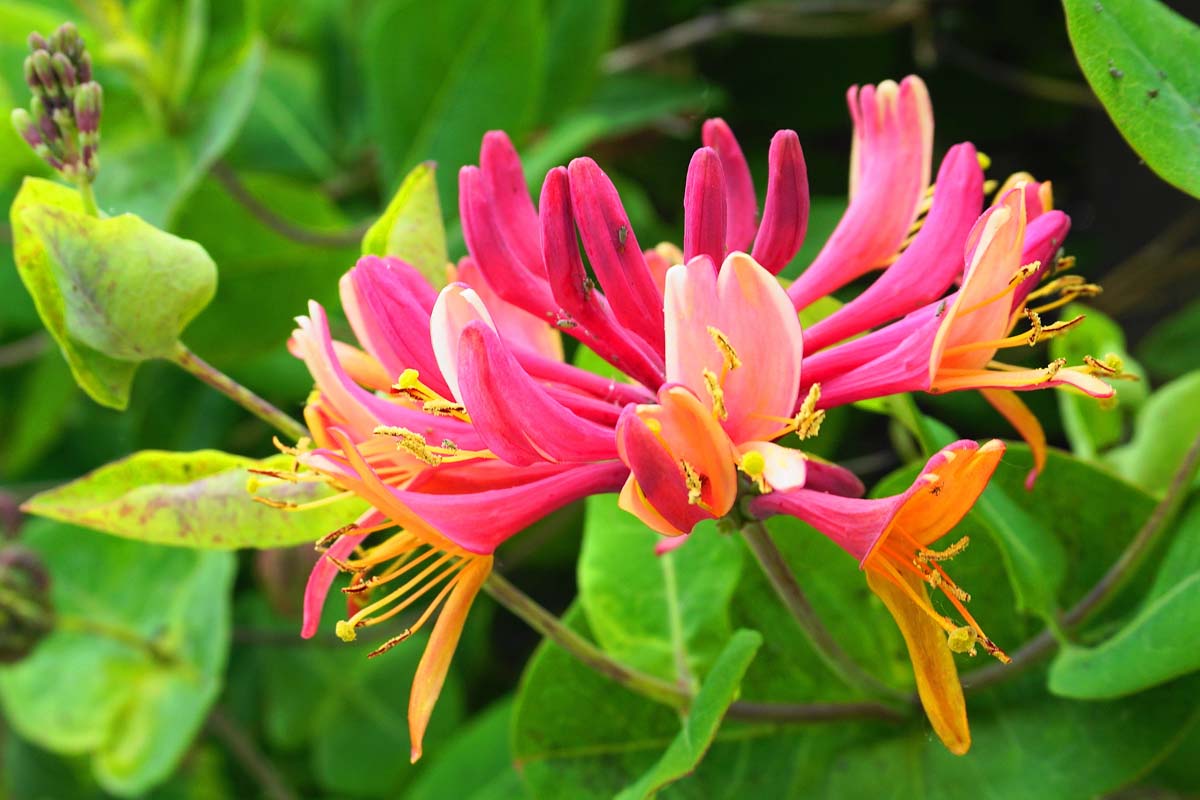
Now you’re ready to go out and start creating your own honeysuckle memories, without the danger of planting something that’s all wrong for your area.
Be sure to come back and let us know which species you end up with and how it’s doing in your yard in the comments below.
Then, if you’re looking for more help on growing flowering vines in your garden, read these guides next:
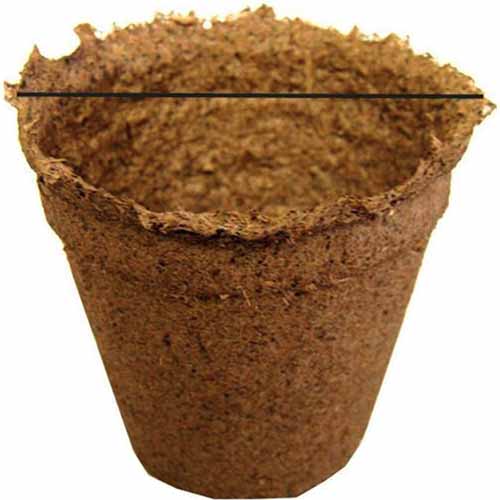

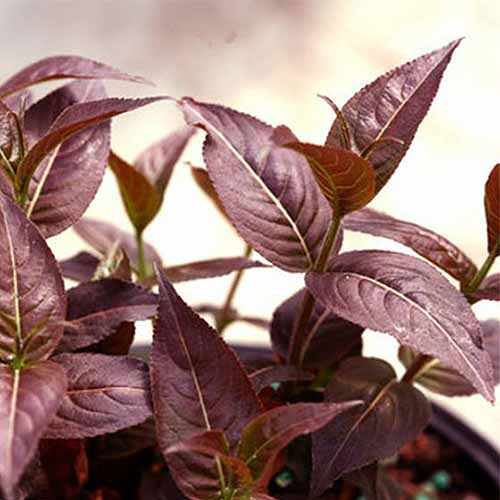
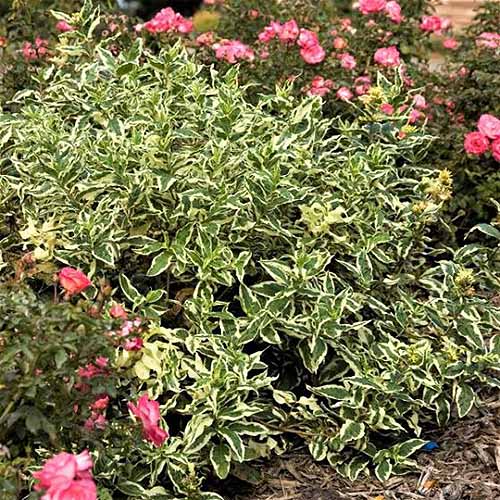


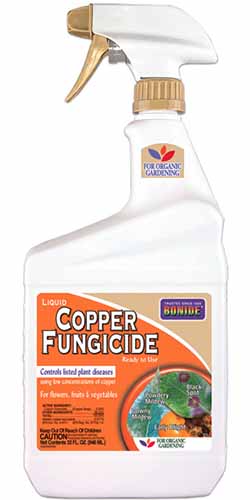
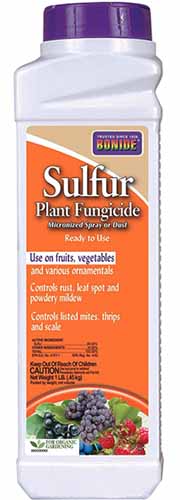
Love your wonderful advice.
I am planning a cottage garden and would very much appreciate your advice.
I would like to plant a Hall’s Honeysuckle on my deck, so that we can enjoy the fragrant flowers. I would plant in a large pot and place a trellis in the pot for the climbing vine. My question: Would the honeysuckle do well in a large pot, or not? (I realize the best place for the vine would be in the ground). Thanks in advance for your advice
Thank you so much for such an informative article! I have been wanting to plant honeysuckles on my back fence, but had no idea how many different kinds of vines/bushes there were until I started researching them. It has been a confusing search, and narrowing down which kind I want to plant has been difficult until I came across your page. Thank you for such wonderfully clear guidance and clarification! Again, many thanks for the help!
Thank you so much for the kind comments! I’m glad that our guide could help you narrow down your search. They’re such wonderful plants, I hope you enjoy whichever you select.